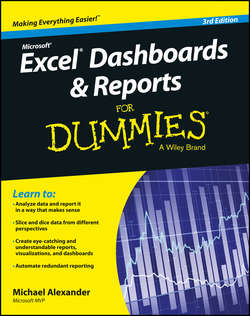Excel Dashboards and Reports for Dummies

Реклама. ООО «ЛитРес», ИНН: 7719571260.
Оглавление
Alexander Michael. Excel Dashboards and Reports for Dummies
Introduction
About This Book
Foolish Assumptions
How This Book Is Organized
Icons Used In This Book
Beyond the Book
Where to Go from Here
Part I. Getting Started with Excel Dashboards & Reports
Chapter 1. Getting In the Dashboard State of Mind
Defining Dashboards and Reports
Preparing for Greatness
A Quick Look at Dashboard Design Principles
Key Questions to Ask Before Distributing Your Dashboard
Chapter 2. Building a Super Model
Data Modeling Best Practices
Excel Functions That Really Deliver
Using Smart Tables That Expand with Data
Part II. Building Basic Dashboard Components
Chapter 3. Dressing Up Your Data Tables
Getting Fancy with Custom Number Formatting
Chapter 4. Sparking Inspiration with Sparklines
Introducing Sparklines
Understanding Sparklines
Customizing Sparklines
Chapter 5. Formatting Your Way to Visualizations
Enhancing Reports with Conditional Formatting
Using Symbols to Enhance Reporting
Wielding the Magical Camera Tool
Making Waffles with Conditional Formatting and the Camera Tool
Chapter 6. The Pivotal Pivot Table
An Introduction to the Pivot Table
The Four Areas of a Pivot Table
Creating Your First Pivot Table
Customizing Pivot Table Reports
Creating Useful Pivot-Driven Views
Part III. Building Advanced Dashboard Components
Chapter 7. Charts That Show Trending
Trending Dos and Don’ts
Comparative Trending
Emphasizing Periods of Time
Other Trending Techniques
Chapter 8. Grouping and Bucketing Data
Creating Top and Bottom Displays
Top Values in Charts
Using Histograms to Track Relationships and Frequency
Chapter 9. Displaying Performance against a Target
Showing Performance with Variances
Showing Performance against Organizational Trends
Using a Thermometer-Style Chart
Using a Bullet Graph
Showing Performance against a Target Range
Part IV. Advanced Reporting Techniques
Chapter 10. Macro-Charged Dashboarding
Why Use a Macro?
Recording Your First Macro
Running Your Macros
Enabling and Trusting Macros
Examining Some Macro Examples
Chapter 11. Giving Users an Interactive Interface
Getting Started with Form Controls
Using the Button Control
Using the Check Box Control
Toggling a Chart Series On and Off
Using the Option Button Control
Showing Many Views through One Chart
Using the Combo Box Control
Changing Chart Data with a Drop-Down Selector
Using the List Box Control
Controlling Multiple Charts with One Selector
Chapter 12. Adding Interactivity with Pivot Slicers
Understanding Slicers
Creating a Standard Slicer
Getting Fancy with Slicer Customizations
Controlling Multiple Pivot Tables with One Slicer
Creating a Timeline Slicer
Using Slicers as Form Controls
Part V. Working with the Outside World
Chapter 13. Using External Data for Your Dashboards and Reports
Importing Data from Microsoft Access
Importing Data from SQL Server
Leveraging Power Query to Extract and Transform Data
Chapter 14. Sharing Your Workbook with the Outside World
Protecting Your Dashboards and Reports
Linking Your Excel Dashboards to PowerPoint
Distributing Your Dashboards via a PDF
Distributing Your Dashboards to OneDrive
Limitations When Publishing to the Web
Part VI. The Part of Tens
Chapter 15. Ten Chart Design Principles
Avoid Fancy Formatting
Skip the Unnecessary Chart Junk
Format Large Numbers Where Possible
Use Data Tables Instead of Data Labels
Make Effective Use of Chart Titles
Sort Your Data before Charting
Limit the Use of Pie Charts
Don’t Be Afraid to Parse Data into Separate Charts
Maintain Appropriate Aspect Ratios
Don’t Be Afraid to Use Something Other Than a Chart
Chapter 16. Ten Excel Chart Types and When to Use Them
Line Chart
Column Chart
Clustered Column Chart
Stacked Column Chart
Pie Chart
Bar Chart
Area Chart
Combination Chart
XY Scatter Plot Chart
Bubble Chart
About the Author
Author’s Acknowledgments
Отрывок из книги
The term business intelligence (BI), coined by Howard Dresner of Gartner, Inc., describes the set of concepts and methods to improve business decision-making by using fact-based support systems. Practically speaking, BI is what you get when you analyze raw data and turn that analysis into knowledge. BI can help an organization identify cost-cutting opportunities, uncover new business opportunities, recognize changing business environments, identify data anomalies, and create widely accessible reports.
Over the past few years, the BI concept has overtaken corporate executives who are eager to turn impossible amounts of data into knowledge. As a result of this trend, whole industries have been created. Software vendors that focus on BI and dashboarding are coming out of the woodwork. New consulting firms touting their BI knowledge are popping up virtually every week. And even the traditional enterprise solution providers, like Business Objects and SAP, are offering new BI capabilities.
.....
In Part II, you take an in-depth look at some of the basic dashboard components you can create using Excel. Chapter 3 starts you off with some fundamentals around designing effective data tables. Chapter 4 shows you how you can leverage the Sparkline functionality found in Excel. Chapter 5 provides a look at the various techniques that you can use to visualize data without the use of charts or graphs. Chapter 6 rounds out this section of the book by introducing you to pivot tables and discussing how a pivot table can play an integral role in Excel-based dashboards.
In Part III you go beyond the basics to take a look at some of the advanced chart components you can create with Excel. This part consists of three chapters, starting with Chapter 7, where I demonstrate how to represent time trending, seasonal trending, moving averages and other types of trending in dashboards. In Chapter 8, you explore the many methods used to bucket data – putting data into groups for reporting, in other words. Finally, Chapter 9 demonstrates some of charting techniques that can help you display and measure values versus goals.
.....